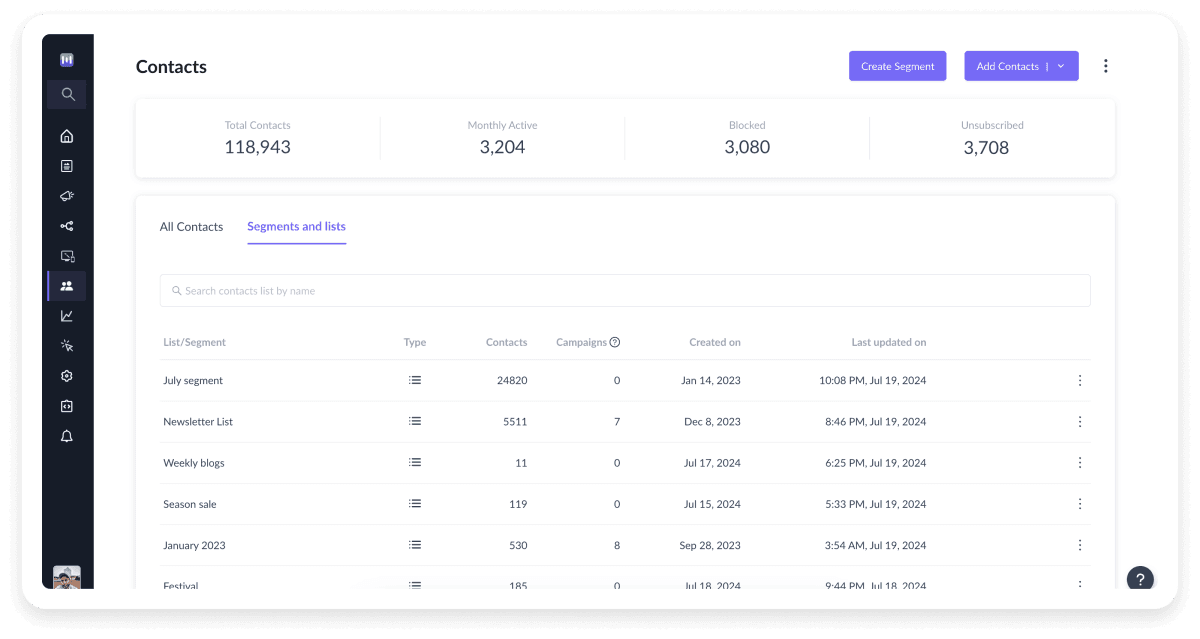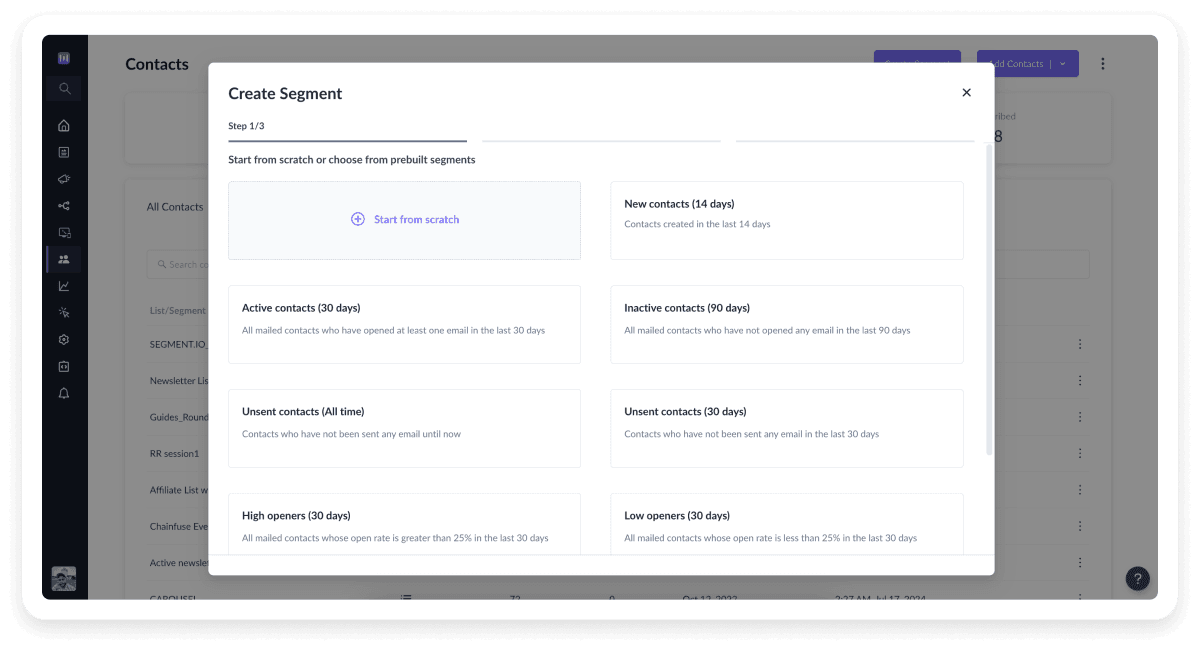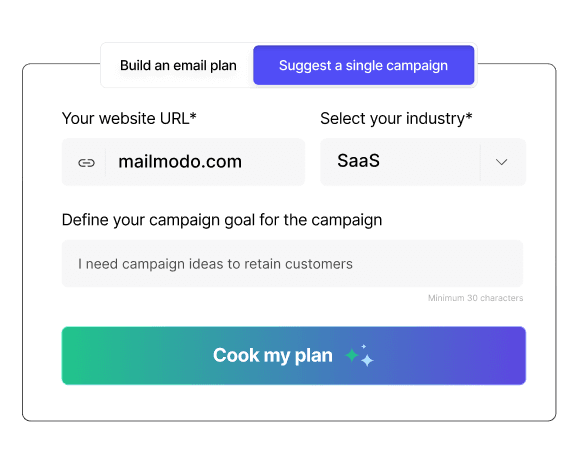What is an email marketing database?
An email marketing database is a structured collection of email addresses and other relevant information collected from prospects to send targeted campaigns. This database may include demographic data, contact lists, preferences, browsing history, and even records of past purchases.
An email marketing database allows you to keep track of your recipients’ preferences, helping you to understand their needs and behaviors better. You can use this information to run targeted campaigns and cater to specific interests, increasing your messages' relevance.
You can also segment your audience based on different properties, which helps you to personalize your emails better, ensuring that your emails resonate with your recipients.
Additionally, your emails are more likely to be seen as relevant by your audience and get more engagement, increasing your email deliverability rates.
What kind of data does an email marketing database contain?
An email marketing database can contain vast amounts of data in a structured manner. It may include:
| Category |
Details |
| Contact Details |
Email address, names, phone number |
| Demographic Details |
Age, location, gender |
| Preferences and Interests |
Subscriber preferences for content type and products |
| Segmentation Data |
Tags for segmenting subscribers depending on interests, opt-in sources, customer type |
| Purchase Behavior |
Records of previous purchases, order details, transaction history |
| Behavioral Data |
Interactions on web pages or landing pages such as pages visited, products viewed, clicks, conversions, email open rates, unsubscribes |
| Opt-out Information |
Details of subscribers who unsubscribed or opted-out |
Difference between email list and email marketing database
You, like many other people, might think that email lists and email databases are the same, but that’s not the case. While email lists and email marketing databases both involve storing and managing subscriber information, they are still very different.
An email list is a collection of email addresses that you get when people sign up to receive communications from your business and usually contains just the email address of the subscriber. An email marketing database, on the other hand, is a comprehensive collection of subscriber information, including names, demographic information, purchase history, engagement data, and preferences.
The kind of information that an email database contains may be collected over time by tracking user behavior, website interactions, purchase history and so on , whereas the data in email lists are usually gathered through opt-in forms on your website.
An email list also offers limited personalization owing to the limited amount of data that they have, while email marketing databases offer deeper and more detailed personalization in your campaigns.
How to manage your email marketing database
As your email lists expand, your email marketing database will also grow automatically. However, growing and managing an email marketing database needs more work than just collecting and storing email addresses. Here are some of the best ways you can manage an email marketing database:
1. Use permission-based opt-in
Always ask subscribers for their consent to opt-in for your emails. This ensures that people are genuinely interested in providing their email addresses and want to receive your marketing emails.
Use double opt-in where subscribers receive an email link to confirm their subscription. This way, you can filter out disinterested people or mistyped email addresses.
Include an unchecked checkbox in your opt-in forms. People can check it if they prefer to get additional updates from you.
Here’s how Tommy Hilfiger uses a permission-based opt-in form on its website to collect email addresses with the subscriber's consent.

2. Create an email sunset policy
If your email subscribers haven’t engaged or responded to your emails for a while, removing them is the best option. An email sunset policy helps remove inactive subscribers after a specific period and gets rid of the extra information that you won’t need or isn’t useful to you.
Create the email sunset policy for your business based on parameters such as the activities you track to segment your subscribers and the time since your subscribers have been inactive.
Track your subscriber’s activity for at least 60 to 90 days before taking any action.
Ask yourself questions like: Are they opening your emails or not? Have they interacted with them if opened? This helps you determine the people you need to remove.
Segment inactive subscribers and send “Miss-you” emails to win back those who haven't interacted with your emails. This is like the last call for them. If they don’t respond, delete them from your list.
Udemy sent the email below to its inactive subscribers, asking them to confirm their interest in remaining subscribed to Udemy’s emails, offering a discount of $10, and setting a deadline to do so.

3. Clean your email database
There is no point in having irrelevant and disengaged contacts in your email database. Therefore, it is important to maintain a clean email marketing database. Ask for and collect only the information that you need or might need in the future.
Verify emails using a free email address validator to ensure you have a valid email list.
Check for inconsistencies in the collected customer data and fix them. Also, remove any duplicates that you might have in the database.
Tags are labels that you can add to the subscribers in your list depending on criteria such as interests, demographics, purchase history, and so on.
Here are some tags you can use:
If a subscriber clicks on a link to a specific product in your email, you could assign a tag “interested-in-product-X.”
You can use demographic tags such as age (18-25, 26-35, 36-45) and location tags(by city, state, country).
For behavioral characteristics use tags based on engagement level (active, inactive, engaged, disengaged), signup source ( website, referral), and purchase history (buyer, non-buyer).
You can use activity tags (opened email, clicked a link, abandoned cart, made a purchase) for subscriber activities.
You can use lifecycle stage tags such as lead generation (new, qualified, nurturing), customer (new, repeat), and subscriber (new, loyal).
5. Name your email lists
Naming your email list gives context about what kind of subscribers that list contains. For instance, it could tell you where your subscribers came from, how they signed up, or what offerings they are interested in.
For example, an email list name such as “Engaged readers” indicates this is a list of subscribers who frequently open and click through your emails. For the ones who engage less, you can use a name such as “Occasional readers.”
Proper email list names make tracking the performance of subscriber groups and campaigns easy. Further, you can label your email segments as static or dynamic, depending on the kind of segmentation you’re using.
6. Enrich your data
Enriching data allows you to add valuable contact properties to existing email contacts. For example, you can include data such as social media profiles, contact numbers, and much more. You can do this by collecting more information about your subscribers by conducting surveys, tracking their activity, and even conducting polls and contests. You can also create a custom property to customize data according to your needs.
How can Mailmodo help you organize your email database
Maintaining an email marketing list and managing it manually is extremely difficult, especially if you have a large email marketing database. It’s a good idea to use a CRM (Customer Relationship Management) to help you do this. You also have ESPs that allow you quite a few functionalities to manage your email marketing database better. It’s a good choice to use ESPs because it doesn’t just allow you to manage your email database but also set up your email campaigns.
Mailmodo, for instance, is an ESP that helps you create and send interactive emails that grab attention and prompt action without any coding. These AMP-powered interactive emails also allow you to conduct surveys and polls within your emails. This makes it even more appealing for marketers who want to collect more information about their subscribers.
Create campaign ideas with
AI Email Campaign Planner
Additionally, it allows you to consolidate all your contacts from several different sources into a single database. You can import contacts via different methods, like uploading a CSV file, through APIs, through Mailchimp and more, as you can see in the image below. You can also connect your forms and landing pages to fetch contacts continuously.

By importing your contacts into Mailmodo, you can categorize them into different lists and even create static and dynamic segments.
Static segments allow you to define membership based on certain conditions, such as past purchases or historical data. The contacts that fulfill the specified condition at the time of creation are included in the static segment.
Dynamic segments, on the other hand, automatically group people when they meet a specific criterion. The contacts join the segment when they fulfill the conditions and leave when they no longer do. Thus, you can group people based on real-time activities in these segments. The contacts that meet segment conditions at the time of creation and in the future will be dynamically updated. Mailmodo allows you to create these segments with a single click for some pre-defined conditions, or you can choose to start from scratch.

Conclusion
It is important to have an email marketing database that has valid and relevant information about your subscribers. You must ensure you grow and nurture your email database correctly to keep delivering the right content to your subscribers and expand your outreach.
Additionally, complying with data laws and refining email marketing strategies are equally essential to building strong relationships and an online reputation. Growing an email marketing database isn’t about having a lot of contacts; it’s more about knowing your subscribers and having meaningful connections with the people who are interested in hearing from you.










































